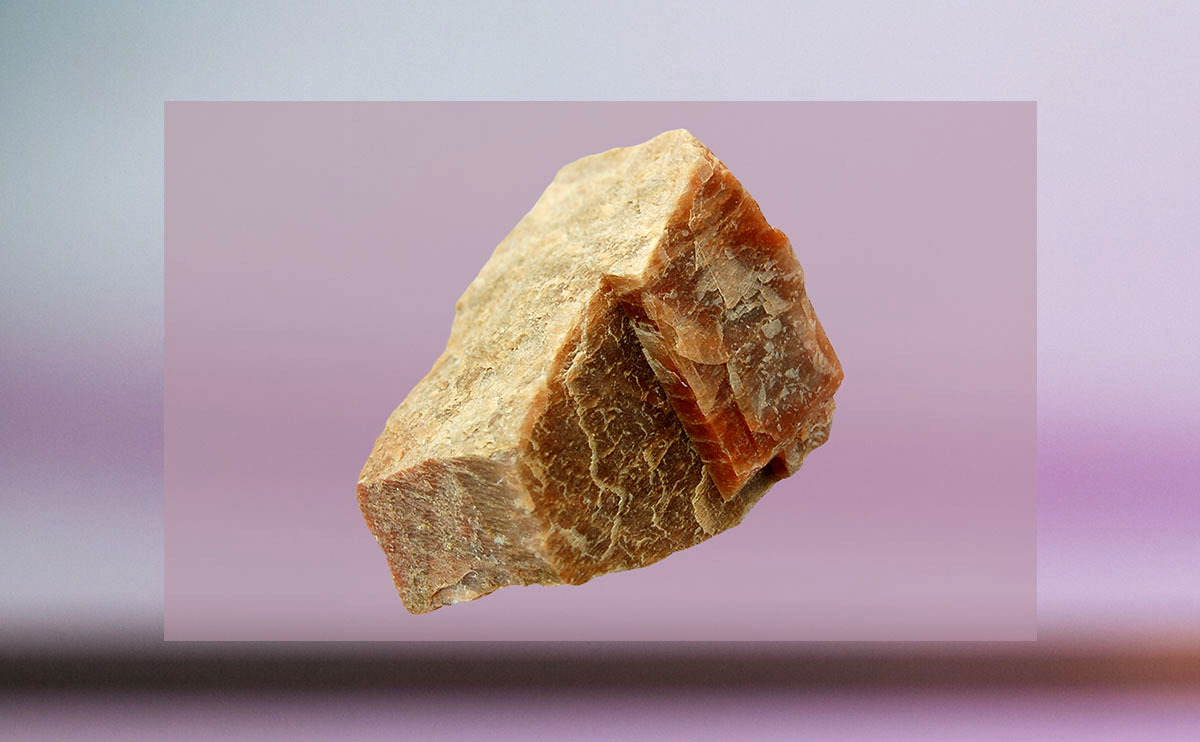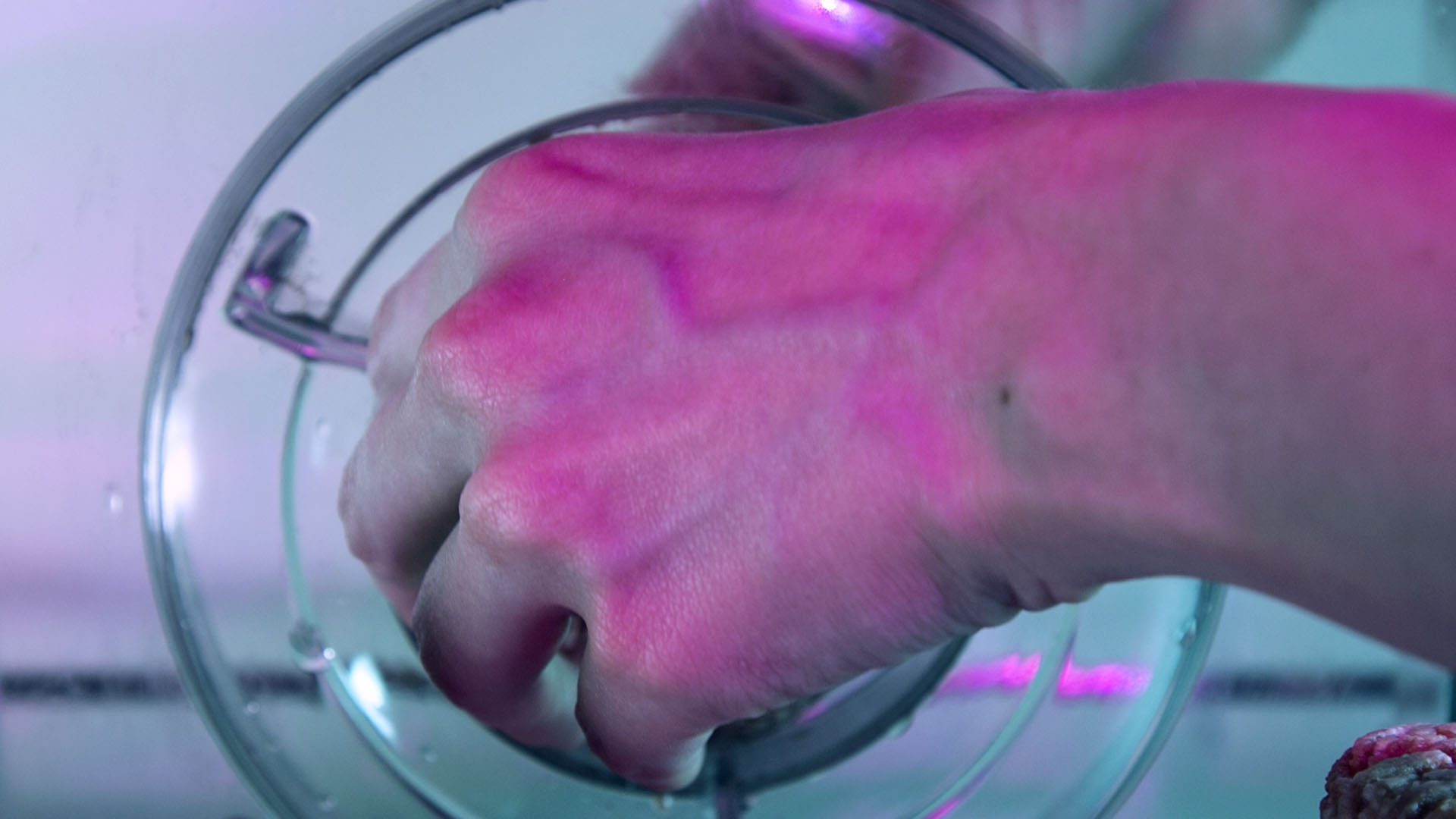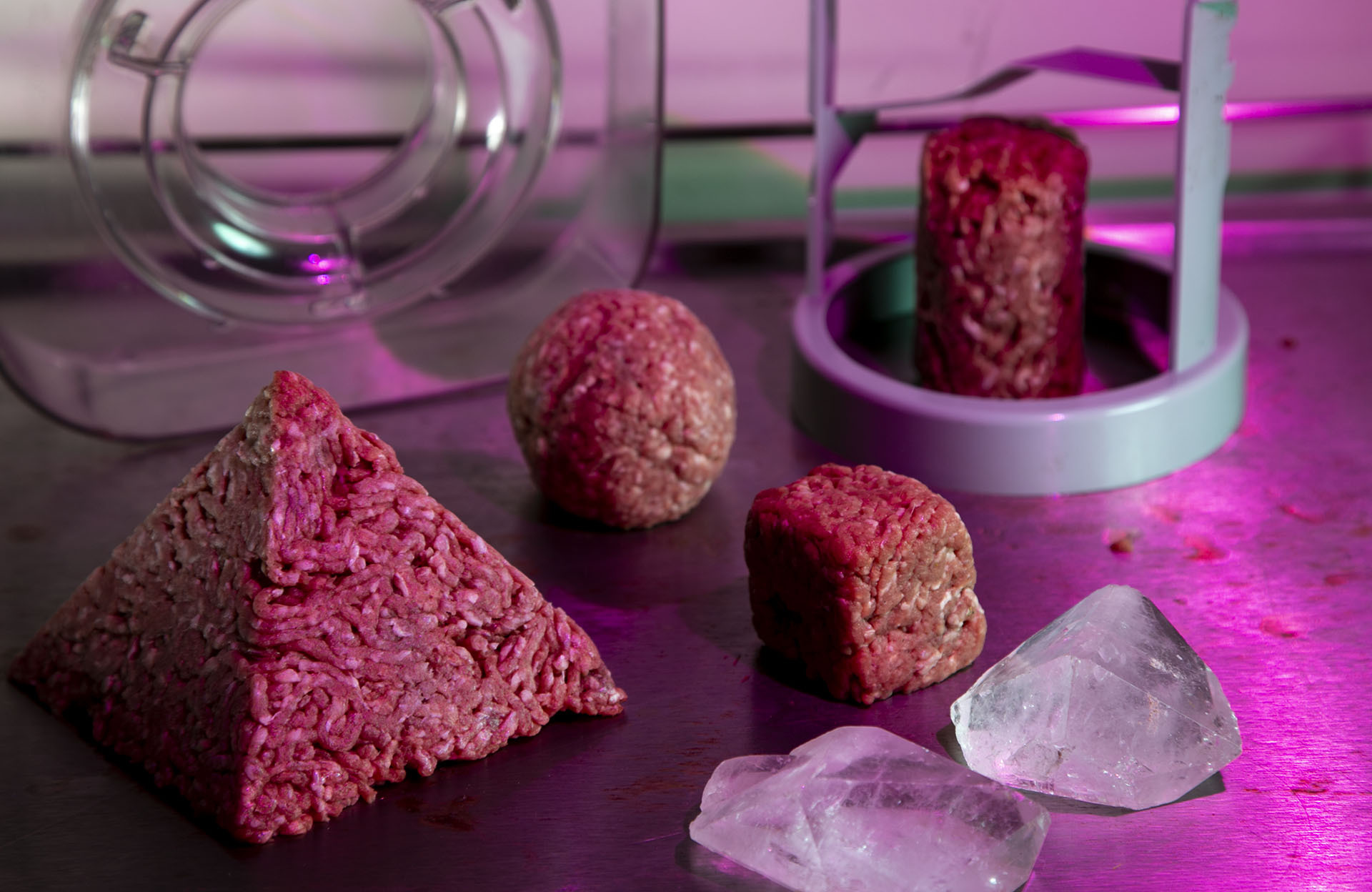The Critter Issue
Mystery Meat
Can society acquire a taste for lab-grown animal tissue?
Most meat eaters don’t want to think about where their food comes from — but what if the animal you were eating was present at the dinner table, walking, clucking, maybe even staring at you straight in the face? No, you’re not eating the animal alive; you’re simply enjoying a dish that was grown in a lab from its cells. The donor animal, with no harm done to it, continues to live out the remainder of its life in the blissful setting of an idyllic farm.
Many attribute the first mention of eating lab-grown meat to Winston Churchill, who wrote in Popular Mechanics in 1932, “We shall escape the absurdity of growing a whole chicken in order to eat the breast or wing, by growing these parts separately under a suitable medium.” Nearly four decades later, in 1971, muscle tissue was successfully grown in vitro by University of Washington researcher Russell Ross (guinea pig muscle, if you’re curious). But it wasn’t until the turn of the 21st century that cultured meat was successfully made for human consumption.
To some, lab-grown meat might sound like something straight out of science fiction, but commercial lab-grown meat is already a reality. The process is, in fact, relatively simple. To begin, starter cells (which multiply quickly and are ideal for growth) are collected from an animal, often via biopsy. Stem cells are a typical choice because scientists can trigger their growth into different types of cells, such as muscle fiber or fat, a must-have for growing the types and cuts of meat most people love to eat.
Once the cells are collected, a protein source must be added to promote tissue growth. This culture is then placed in a bioreactor that supplies vast amounts of energy, spurring the growth of the meat. A scaffold, ideally biodegradable or edible, may be provided to give the growing tissue shape for more complex cuts of meat.
Mosa Meat is one of a handful of startups currently hoping to make cultured meat at-scale. In fact, the Netherlands-based company was one of the first on the cultured meat. Mosa Meat grew out of a research group at Maastricht University founded by Dutch researcher and entrepreneur Willem van Eelen, who filed one of the first patents on growing meat in a lab for human consumption back in 1997.
“He’s sort of considered the godfather of all this,” says Peter Verstrate, CEO of the food research company. Around the time of van Eelen’s development, NASA also began experimenting with growing meat for human consumption in space, resulting in edible goldfish muscle in 2002.
While the technology behind lab-grown meat has come a long way since those early days of exploration, don’t expect to find a T-bone steak born from a petri dish at the grocery store any time soon. For now, most lab-grown meat products are ground or minced (producing things like hamburger or chicken nuggets), which can be grown and shaped without the need for bones and excess fat — features that are deeply linked to the taste and texture of premium cuts of meat. In fact, verisimilitude is incredibly important to the companies developing cultured meat today.
“If it’s not exactly the same, you will immediately end up in the category of products that try to mimic meat,” says Verstrate, and that’s not exactly what most people in the cultured meat industry are aiming for.
Making more complex cuts of meat, however, would require simulating a wide array of bodily processes within the lab. For one thing, the scaffolding that shapes tissue growth would ideally have to move in order to simulate the movement of the muscle. The lab-grown meat products would also require channeling systems that could provide nutrients and remove waste from the tissue, mimicking the role of blood vessels. Some cultured meat companies are currently working on these processes, but the focus, for now, is simply ensuring cells can be fed in a way that spurs growths both sustainably and affordably.
As with many things in science, that’s really one of the biggest challenges here: economics. While growing tissue from a cell culture has been achieved successfully within the medical field, the process has not yet been done on a large, marketable scale like conventional meat production. But meat consumption is on the rise, and there are many more hungry mouths to feed than there are people who need a heart grown from a lab. When MosaMeat first unveiled their cultured hamburger patty in 2013, it cost €250,000 to produce. The demoed patty “was in the most literal sense of the word a handmade product,” says Verstrate. If mass produced at-scale, its CEO estimates the patty would reduce in cost to around $60-70 dollars, but that’s “obviously not low enough yet.”
Another big challenge to cultured meat production at-scale is finding an economical protein source to feed the animal cells. Currently, fetal bovine serum is a common protein source for growing cell cultures, but it’s very expensive. One might also argue that using an animal-derived protein source undermines the goals of producing so-called “clean meat.” In fact, the majority of research behind scaling cultured meat for human consumption right now is to perfect an affordable, plant-based protein source that can quickly grow the cells.
One company doing just that is JUST, a San Francisco-based startup that’s spent more than five years researching plant proteins that behave similarly to their animal counterparts. They also work with farmers to develop sustainable production processes for turning those proteins into animal product substitutes. One of JUST’s products, for example, is a scrambled egg substitute made from mung bean. Other products include split pea mayonnaise, and it’s crowning jewel — a plant-fed, lab-grown sirloin steak. Having created several such substitutes, JUST has a lot of data they can use to optimize a sustainable, affordable solution for feeding animal cells.
“This is where the knowledge we have acquired over the past few years really is fundamental for our approach because we’re using plant-based proteins for our culture media,” says Vitor Santo, Ph.D., a senior scientist on Just’s cellular agriculture team. “We are replacing everything that is animal-derived in this culture supplement.”

But there’s still the question of appealing to consumers themselves, as echoed in Verstrate’s concern that such products might be recognized as merely a “meat substitute.” Folks like Santo argue that cultured meat is real meat, genetically identical to the conventionally-produced kind we buy on supermarket shelves. But helping consumers get over the idea of what’s real and what isn’t, what’s natural or not, is a big hurdle in itself for the industry.
One can’t overstate the benefits of cultured meat. Unlike livestock, lab-grown meat has virtually no risk of carrying disease, uses far less land and water consumption per pound of meat, and results in significantly fewer greenhouse gas emissions (whether its carbon output from factory farms or the millions of tons of methane produced every year by the livestocks’ digestive processes). And of course, it eliminates animal cruelty and the need for slaughter.
Yet, despite these benefits, some consumers find the idea a bit difficult to swallow. In a 2015 study of consumer responses to lab-grown meat, participants said they were “repulsed at the idea that cultured meat was created in a petri dish, something they associated with in-vitro fertilization and creating babies,” or “science-fiction and Frankenstein’s monster.” It’s worth noting that, contrary to consumer assumptions, cultured meat technically isn’t produced in a petri dish.
This stigmatized notion of “Frankenfood” or artificiality, ironically isn’t lost on the conventional meat industry, which often touts its natural qualities. From factory farms where livestock is fed steroids and antibiotics, to free-range animals feeding on a diet of GMOs, it’s difficult to make a firm distinction between what constitutes as “natural” versus “designed” in consumer consciousness. How does the conventional meat industry make such an appeal to nature while simultaneously marketing lumps of meat, unrecognizable from the living bodies they once were? What makes mechanically separated meat appealing to those who balk at the idea of meat grown in a lab? A combination of careful marketing tactics, social programs, and industry advocacy allow for an industrial sleight-of-hand that obscures the process of how conventional meat moves from the farm to your dinner plate.
In fact, the notion of what constitutes as “natural” or not in the meat industry isn’t very helpful from a technical standpoint. Agriculture by definition is a process in which farmers have slowly changed the genetic makeup of plants and animals over generations for efficiency and scalability. This is especially apparent in conventional livestock breeding, in which breeding societies have designed cattle breeds with very specific aesthetic traits for peak marketability.
In 2013, human geographers Lewis Holloway and Carol Morris conducted an extensive study on the creation of aesthetic “truths” within the UK’s livestock breeding culture, detailing ritualistic evaluation shows that eerily resemble beauty pageants and reinforce the community’s standards of beauty. During their research, Holloway and Morris recorded that through generations of breeding influenced by these public evaluations, “a formal, written definition of what an ideal representative animal of a particular breed should look like” has emerged.
The artifice of traditional livestock is further underscored by its connoisseurship, in which a so-called “breeder’s eye” is cultivated to identify which animals are the most aesthetically pleasing and marketable. This special knowledge grants the “ability to make judgments of the relative quality of what is being viewed,” write the researchers, much like the how an art critic would evaluate a painting or architectural design. The most aesthetically pleasing specimens are those deemed fit to carry on their genes, while others go to slaughter. An animal’s agency and functionality, therefore, is “partly related to the human ‘creative’ or ‘crafting’ processes which have led to the domestic animal in front of us.”
With a livestock population that’s deeply embedded within a system of assessment on human design, essentially a system of eugenics, lab-grown meat might not seem comparatively peculiar after all. One might even argue that designed, lab-grown meat is the natural conclusion to the pursuit of a platonic ideal that livestock breeders have pursued for centuries: the perfectly appealing, perfectly sustainable mass of meat produced without the messiness of having to raise animals with varying genetic potential or risk of disease. But until we get over our own fears of lab-grown meat products, these companies are facing an uphill battle.
Consumers have their own aesthetic demands too, which can result in farmers’ going to even further artificial lengths to fit within an idealized assumption of what’s “natural.” For example, because New Zealanders prefer bright yellow egg yolks under the (erroneous) assumption that free-range chickens result in brighter yolks, farmers began dying their yolks by changing chickens’ diets. Today, consumers often trust a product’s visual appeal over labeled certifications (or lack thereof), showing just how powerful the aesthetic process of human crafting can be in deeming our tastes.
Another reason why consumer concerns mismatch the reality of traditional animal product production is because the livestock industry intentionally obfuscates an animal’s journey from farm to table. Consider this coloring book designed by Fork More Pork, a non-profit association of Indiana pork farmers, “that tells the story of how pork is farmed.” While the book portrays pigs at a rustic farm feeding and being treated by a friendly veterinarian, there is no explanation for what happens when it’s time to go to slaughter. Instead, we get this curt, matter-of-fact line: “When pigs leave the farm, they go to a plant where they become food such as pork chops, ham, sausage, and bacon.”
Even industry attempts at informing customers about their food can be confusing at best: for instance, the ambiguous labeling of food certifications like “organic,” “free-range,” and “non-GMO.” Santo from JUST believes cultured meat companies can provide greater transparency to alleviate consumer concerns.
“You know which cells you’re eating, you can have information on all the biological components of the cells, on how they work,” he tells to me, moving on to describe what it was like living on a farm during his childhood. “I had access to animals on the farm, so I knew exactly what I was eating.” Later, when Santo moved to the city, that luxury was lost. “Even though I really like meat, I have no control over what I’m eating, and that’s something that I don’t like,” he told me. In Santo’s worldview, lab-grown meat — which might conjure up sterile, unnatural and uncanny valley-esque images of dystopian food production in some consumers’ minds — might one day allow customers relate better to meat’s journey from lab to dinner plate.

Some consumers and lobbyists also argue that mainstream cultured meat production could eradicate social tradition and agricultural systems that communities thrive and depend on. In the consumer study mentioned above, “The participants struggled to imagine a world where farm animals and the ecosystem they belong to no longer existed.”
While slaughterhouses might eventually give way to clean meat plants, those depending on the conventional meat industry probably don’t have much to worry about in the short-term: cultured meat startups are now actually eying investors from the traditional meat industry. It’s an interesting premise: by investing in cultured meat firms, mainstream meat companies might be able to produce products faster and more sustainably. Meanwhile, the cultured meat startups would have access to the pre-existing meat supply chain and infrastructure built by those companies.
As for ranch communities with a deep culture for livestock breeding, Mosa Meat’s Peter Verstrate offers an optimistic vision of how cultured meat production could empower, not threaten, such communities.
“What I do see emerging would be a way a more decentralized way of producing meat,” he told me. “Let’s say on a local community level — like 10, 20, 50 thousand people or what have you — you are provided with meat from a couple of living animals that live in that same area who are used as stem cell donors. The meat is produced locally in an adjacent factory, and it stays local.” It’s a compelling alternative to current systems in which consumers and ranchers alike are removed from the corporatized food production process, which happens in plants far away.
So, what will it take for everyday consumers to embrace lab-grown meat? It turns out, a sizeable number of consumers are already open to at least trying it. In a 2013 study from The Netherlands, 52% of participants expressed interest in trying the meat; in a similar study conducted by the Guardian later that year found that two-thirds of people surveyed were willing to try cultured meat products.
Presenting consumers with the opportunity to see, smell and taste the meat, once such demos reach a more practical cost than Mosa Meat’s €250,000 burger, would also be a great way to get curious consumers on-board with the new food technology. It’s not hard to argue that cultured meat producers can (and should) use these demonstrations against the conventional industry’s lack of transparency for their benefit.
Will cultured meat be able to one day shirk its air of novelty and enter into the mainstream diet? Shir Friedman, co-founder, and CCO of SuperMeat, another of such companies, thinks so.
“We believe that within the next decade we will see a world where clean meat will become an everyday traditional product on store shelves all around the world, and we will be wondering how we ever lived without it,” she told me.
In the meantime, that gives us plenty of time to enjoy a good burger or steak. Until the utopian future of clean meat arrives, I’ll cautiously stick a fork in some mystery meat.

Joe Sutton is a writer based in Brooklyn and began his beetle-raising hobby in 2017. Follow him on Twitter.
Photography by Marcus McDonald. He is a New York-based photographer, filmmaker and musician. His work deals with representations of artists and the art they make, and different realities and universes. His favorite animal is the Giant Anteater.